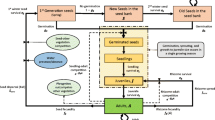Abstract
Mathematical models for weed dispersal and control are developed, analyzed and numerically simulated. A model incorporating periodic control, e.g. herbicide application, is derived for a plant population in a spatially homogeneous setting. The model is extended to a spatially heterogeneous population where plant dispersal is incorporated. The dispersal and control model involves integrodifference equations, discrete in time and continuous in space. The models are analyzed to determine values of the control parameter that prevent weed spread. The effects of the control on travelling wave solutions are investigated numerically.
Similar content being viewed by others
References
Allen, E. J., L. J. S. Allen and X. Gilliam. 1996. Dispersal and competition models for plants.J. Math. Biol. 34, 455–481.
Allen, L. J. S. 1994. Some discrete-timeSI, SIR, andSIS epidemic models.Math. Biosci. 124, 83–105.
Allen, L. J. S., E. J. Allen, C. R. G. Kunst and R. E. Sosebee. 1991. A diffusion model for dispersal ofopuntia imbricata (cholla) on rangeland.J. Ecol. 79, 1123–1135.
Andersen, M. 1991. Properties of some density-dependent integrodifference population models.Math. Biosci. 104, 135–157.
Anderson, R. M. and R. M. May. 1992.Infectious Diseases of Humans, Dynamics and Control. Oxford: Oxford University Press.
Cull, P. 1981. Global stability of population models.Bull. Math. Biol. 43, 47–58.
Edelstein-Keshet, L. 1988.Mathematical Models in Biology. New York: Random House/ Birkhäuser.
Firbank, L. G. and A. R. Watkinson. 1986. Modelling the population dynamics of an arable weed and its effects upon crop yield.J. Appl. Ecol. 23, 147–159.
Ghersa, C. M. and M. L. Rousch. 1993. Searching for solutions to weed problems.BioSci. 43, 104–109.
Hethcote, H. W. 1976. Qualitative analyses of communicable disease models.Math. Biosci. 28, 335–356.
Kot, M. 1992. Discrete-time travelling waves: ecological examples.J. Math. Biol. 30, 413–436.
Kot, M. and W. M. Schaffer. 1986. Discrete-time growth-dispersal models.Math. Biosci. 80, 109–136.
Lacey, J. R. and B. E. Olson. 1991. Environmental and economic impacts of noxious range weeds. InNoxious Range Weeds. L.J. James, J. O. Evans, M. H. Ralphs and R. D. Child, Eds., pp. 5–16. Boulder, CO: Westview Press.
Lui, R. 1982a. A nonlinear integral operator arising from a model in population genetics, I. Monotone initial data.SIAM J. Math. Anal. 13, 913–937.
Lui, R. 1982b. A nonlinear integral operator arising from a model in population genetics, II. Initial data with compact support.SIAM J. Math. Anal. 13, 938–953.
Mollison, D. 1977. Spatial contact models for ecological and epidemic spread.J. Roy. Statist. Soc. Ser. B 39, 283–326.
Pakes, A. G. and R. A. Maller. 1990.Mathematical Ecology of Plant Species Competition. Cambridge: Cambridge University Press.
Weinberger, H. F. 1982. Longtime behavior of a class of biological models,SIAM J. Math. Anal. 13, 353–396.
Author information
Authors and Affiliations
Rights and permissions
About this article
Cite this article
Allen, L.J.S., Allen, E.J. & Ponweera, S. A mathematical model for weed dispersal and control. Bltn Mathcal Biology 58, 815–834 (1996). https://doi.org/10.1007/BF02459485
Received:
Accepted:
Issue Date:
DOI: https://doi.org/10.1007/BF02459485




